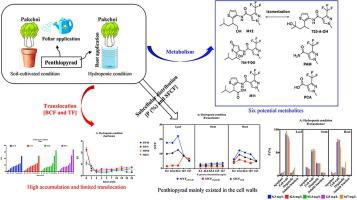当前位置:
X-MOL 学术
›
Pestic. Biochem. Phys.
›
论文详情
Our official English website, www.x-mol.net, welcomes your feedback! (Note: you will need to create a separate account there.)
Unveiling the absorption, translocation, and metabolism of penthiopyrad in pakchoi under hydroponic and soil-cultivated conditions
Pesticide Biochemistry and Physiology ( IF 4.7 ) Pub Date : 2024-03-11 , DOI: 10.1016/j.pestbp.2024.105859 Jinming Chang , Fanxia Liao , Wenhao Xiong , Wang Tian , Kankan Zhang
Pesticide Biochemistry and Physiology ( IF 4.7 ) Pub Date : 2024-03-11 , DOI: 10.1016/j.pestbp.2024.105859 Jinming Chang , Fanxia Liao , Wenhao Xiong , Wang Tian , Kankan Zhang

|
The efficient use of pesticides has long been a topic of public concern, necessitating a thorough understanding of their movement in plants. This study investigates the translocation and distribution of penthiopyrad in pakchoi plants cultivated both in hydroponic and soil-cultivated conditions. Results indicate that penthiopyrad predominantly accumulates in the roots, with concentrations of 11.3–53.9 mg/kg following root application, and in the leaves, with concentrations of 2.0–17.1 mg/kg following foliar application. The bioconcentration factor exceeded 1, with values ranging from 1.2 to 23.9 for root application and 6.4 to 164.0 for foliar application, indicating a significant role in the absorption and accumulation processes. The translocation factor data, which were <1, suggest limited the translocations within pakchoi plants. The limitation may be attributed to the hydrophobic properties of penthiopyrad (log = 3.86), as evidenced by its predominant distribution in the subcellular solid fractions of pakchoi tissues, accounting for 93.1% to 99.5% of the total proportion. Six metabolites (753-A-OH, M12, 754-T-DO, M11, PCA, and PAM) were identified in this study as being formed during this process. These findings provide valuable insights into the absorption, translocation, and metabolism of penthiopyrad in pakchoi.
中文翻译:

揭示水培和土壤栽培条件下小白菜中吡噻菌胺的吸收、转运和代谢
农药的有效使用长期以来一直是公众关注的话题,因此有必要全面了解农药在植物中的运动情况。本研究调查了吡噻菌胺在水培和土壤栽培条件下栽培的小白菜植物中的易位和分布。结果表明,吡噻菌胺主要积聚在根部,根部施用后浓度为 11.3-53.9 mg/kg,叶面施用后浓度为 2.0-17.1 mg/kg 在叶片中。生物富集因子超过1,根部施用的生物富集因子为1.2至23.9,叶面施用的生物富集因子为6.4至164.0,表明在吸收和积累过程中具有显着作用。易位因子数据<1,表明小白菜植物内的易位受到限制。这种限制可能归因于吡噻菌胺的疏水性(log=3.86),其主要分布在小白菜组织的亚细胞固体部分中,占总比例的93.1%至99.5%就证明了这一点。本研究确定了在此过程中形成的六种代谢物(753-A-OH、M12、754-T-DO、M11、PCA 和 PAM)。这些发现为小白菜中吡噻菌胺的吸收、易位和代谢提供了宝贵的见解。
更新日期:2024-03-11
中文翻译:

揭示水培和土壤栽培条件下小白菜中吡噻菌胺的吸收、转运和代谢
农药的有效使用长期以来一直是公众关注的话题,因此有必要全面了解农药在植物中的运动情况。本研究调查了吡噻菌胺在水培和土壤栽培条件下栽培的小白菜植物中的易位和分布。结果表明,吡噻菌胺主要积聚在根部,根部施用后浓度为 11.3-53.9 mg/kg,叶面施用后浓度为 2.0-17.1 mg/kg 在叶片中。生物富集因子超过1,根部施用的生物富集因子为1.2至23.9,叶面施用的生物富集因子为6.4至164.0,表明在吸收和积累过程中具有显着作用。易位因子数据<1,表明小白菜植物内的易位受到限制。这种限制可能归因于吡噻菌胺的疏水性(log=3.86),其主要分布在小白菜组织的亚细胞固体部分中,占总比例的93.1%至99.5%就证明了这一点。本研究确定了在此过程中形成的六种代谢物(753-A-OH、M12、754-T-DO、M11、PCA 和 PAM)。这些发现为小白菜中吡噻菌胺的吸收、易位和代谢提供了宝贵的见解。



























 京公网安备 11010802027423号
京公网安备 11010802027423号